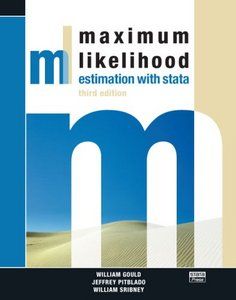Maximum Likelihood Estimation with Stata, Third Edition
Overview
Authors: William Gould, Jeffrey Pitblado, William Sribney 公卫人
Publisher: Stata Press
Copyright: 2006
ISBN-10: 1-59718-012-2
ISBN-13: 978-1-59718-012-2
Pages: 290; paperback
Price: $43.00
Comment from the Stata technical group
Maximum Likelihood Estimation with Stata, 3rd Edition, is written for researchers in all disciplines who need to fit models using maximum likelihood estimation. This edition offers a wealth of material about the ml command, updated to include new features introduced in Stata 9. 公卫百科
Noteworthy features in ml include
constraints() — linear constraints
technique() — four optimization algorithms (Newton–Raphson, DFP, BFGS, and BHHH)
vce(oim) — observed information matrix variance estimator
公卫百科
vce(opg) — outer product of gradients variance estimator
vce(robust) — Huber/White/sandwich/robust variance estimator
svy — complete and automatic support for survey data analysis
公卫人
In addition, the authors give advice for developing your own estimation command and illustrate how to write your estimation command so that it supports the new svy prefix introduced in Stata 9. 公卫人
In the final chapter, the authors illustrate the major steps required to get from log-likelihood function to fully operational estimation command. This is done using several different models: logit and probit, linear regression, Weibull regression, the Cox proportional hazards model, random-effects regression, and seemingly unrelated regression.
公卫人
Table of contents
Preface (pdf)
Versions of Stata
Notation and Typography
1 Theory and practice
1.1 The likelihood-maximization problem
1.2 Likelihood theory
公卫家园
1.2.1 All results are asymptotic
1.2.2 Variance estimates and hypothesis tests
1.2.3 Likelihood-ratio tests and Wald tests
1.2.4 The outer product of gradients variance estimator 公卫人
1.2.5 Robust variance estimates
1.3 The maximization problem
1.3.1 Numerical root finding
Newton's method
The Newton–Raphson algorithm 公卫考场
1.3.2 Quasi-Newton methods
The BHHH algorithm
The DFP and BFGS algorithms
1.3.3 Numerical maximization
公卫考场
1.3.4 Numerical derivatives
1.3.5 Numerical second derivatives
1.4 Monitoring convergence
2 Overview of ml
2.1 The jargon of ml
2.2 Equations in ml 公卫百科
2.3 Likelihood-evaluator methods
2.4 Tools for the ml programmer
2.5 Common ml options
2.5.1 Subsamples
2.5.2 Weights
2.5.3 OPG estimates of variance 公卫家园
2.5.4 Robust estimates of variance
2.5.5 Survey data
2.5.6 Constraints
2.5.7 Choosing among the optimization algorithms
2.6 Maximizing your own likelihood functions
公卫家园
3 Method lf
3.1 The linear-form restrictions
3.2 Examples
3.2.1 The probit model
3.2.2 The normal model: linear regression
3.2.3 The Weibull model
公卫考场
3.3 The importance of generating temporary variables as doubles
3.4 Problems you can safely ignore
3.5 Nonlinear specifications
3.6 The advantages of lf in terms of execution speed
公卫百科
3.7 The advantages of lf in terms of accuracy
4 Methods d0, d1, and d2
4.1 Comparing these methods
4.2 Outline of method d0, d1, and d2 evaluators
公卫家园
4.2.1 The todo argument
4.2.2 The b argument
Using mleval to obtain values from each equation
4.2.3 The lnf argument
Using lnf to indicate that the likelihood cannot be calculated 公卫家园
Using mlsum to define lnf
4.2.4 The g argument
Using mlvecsum to define g
Scores for robust and OPG variance estimates (optional)
4.2.5 The negH argument
公卫考场
Using mlmatsum to define negH
4.2.6 Aside: Stata's scalars
4.3 Summary of methods d0, d1, and d2
4.3.1 Method d0
4.3.2 Method d1
公卫考场
4.3.3 Method d2
4.4 Linear-form examples
4.4.1 The probit model
4.4.2 The normal model: linear regression
4.4.3 The Weibull model
4.5 Panel-data likelihoods
公卫百科
4.5.1 Calculating lnf
4.5.2 Calculating g
4.5.3 Calculating negH
Using mlmatbysum to help define negH
4.6 Likelihoods other than linear form
公卫百科
5 Debugging likelihood evaluators
5.1 ml check
5.2 Using methods d1debug and d2debug
5.2.1 Method d1debug
5.2.2 Method d2debug
5.3 ml trace
公卫考场
6 Setting initial values
6.1 ml search
6.2 ml plot
6.3 ml init
7 Interactive maximization
7.1 The iteration log
7.2 Pressing the Break key
公卫论坛
7.3 Maximizing difficult likelihood functions
8 Final results
8.1 Graphing convergence
8.2 Redisplaying output
9 Writing do-files to maximize likelihoods 公卫百科
9.1 The structure of a do-file
9.2 Putting the do-file into production
10 Writing ado-files to maximize likelihoods
10.1 Writing estimation commands 公卫人
10.2 The standard estimation-command outline
10.3 Outline for estimation commands using ml
10.4 Using ml in noninteractive mode
10.5 Advice
10.5.1 Syntax
公卫考场
10.5.2 Estimation subsample
10.5.3 Parsing with help from mlopts
10.5.4 Weights
10.5.5 Constant-only model
10.5.6 Initial values
10.5.7 Saving results in e()
公卫考场
10.5.8 Displaying ancillary parameters
10.5.9 Exponentiated coefficients
10.5.10 Offsetting linear equations
10.5.11 Program properties
11 Writing ado-files for survey data analysis 公卫考场
11.1 Program properties
11.2 Writing your own predict command
12 Other examples
12.1 The logit model
12.2 The probit model
12.3 The normal model: linear regression 公卫论坛
12.4 The Weibull model
12.5 The Cox proportional hazards model
12.6 The random-effects regression model
12.7 The seemingly unrelated regression model 公卫百科
A Syntax of ml
B Likelihood evaluator checklists
B.1 Method lf
B.2 Method d0
B.3 Method d1
B.4 Method d2
C Listing of estimation commands
公卫论坛
C.1 The logit model
C.2 The probit model
C.3 The normal model
C.4 The Weibull model
C.5 The Cox proportional hazards model
C.6 The random-effects regression model
公卫家园
C.7 The seemingly unrelated regression model
References
Download Freely
http://ishare.iask.sina.com.cn/f/7025893.html
公卫家园
附件列表
您所在的用户组无法下载或查看附件
词条内容仅供参考,如果您需要解决具体问题
(尤其在法律、医学等领域),建议您咨询相关领域专业人士。
如果您认为本词条还有待完善,请 编辑
上一篇 统计学的世界(第五版) 下一篇 河南医科大学公共卫生学院


